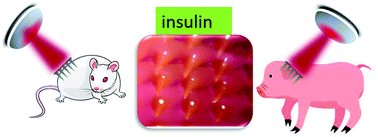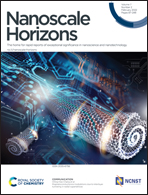Innovative transdermal delivery of insulin using gelatin methacrylate-based microneedle patches in mice and mini-pigs†
Abstract
Painless and controlled on-demand drug delivery is the ultimate goal for the management of various chronic diseases, including diabetes. To achieve this purpose, microneedle patches are gaining increased attention. While degradable microneedle (MN) arrays are widely employed, the use of non-dissolving MN patches remains a challenge to overcome. In this study, we demonstrate that crosslinking gelatin methacrylate with polyethylene glycol diacrylate (PEGDA) is potent for engineering non-dissolving MN arrays. Incorporation of MoS2 nanosheets as a photothermal component into MN hydrogels results in MNs featuring on-demand release properties. An optimized MoS2-MN array patch formed using a hydrogel solution containing 500 μg mL−1 of MoS2 and photochemically crosslinked for 5 min shows required mechanical behavior under a normal compressive load to penetrate the stratum corneum of mice or pig skin and allows the delivery of macromolecular therapeutics such as insulin upon swelling. Using ex vivo and in vivo models, we show that the MoS2-MN patches can be used for loading and releasing insulin for therapeutic purposes. Indeed, transdermal administration of insulin loaded into MoS2-MN patches reduces blood glucose levels in C57BL/6 mice and mini-pigs comparably to subcutaneously injected insulin. We believe that this on-demand delivery system might alter the current insulin therapies and might be a potential approach for delivery of other proteins.

- This article is part of the themed collections: Celebrating International Women’s Day: Women in Nanoscience, Nanoscale and Nanoscale Horizons: Nanobiotechnology and Nanomedicine and Nanoscale Horizons Most Popular 2022 Articles


 Please wait while we load your content...
Please wait while we load your content...